Processes for the production of electro-optic displays, and color filters for use therein
a technology of electrooptic display and process, which is applied in the field of electrooptic display production and filter, can solve the problems of preventing widespread use, inadequate service life of these displays, and gas-based electrophoretic media being susceptible to the same types of problems
- Summary
- Abstract
- Description
- Claims
- Application Information
AI Technical Summary
Benefits of technology
Problems solved by technology
Method used
Image
Examples
Embodiment Construction
[0058]As already mentioned, the present invention provides three different processes for depositing multiple types of color filter materials on a substrate. These three processes will primarily be described separately below, but first consideration will be given to certain issues common to all of the processes.
[0059]The processes of the invention are of course restricted to color filter materials which can survive the process without loss of their color or color-developing ability, and (in some cases) which can be prepared in the necessary flowable or liquid forms. Similarly, a color filter material which cannot be formed into a substantially solid layer, which can be ruptured as required to enable portions of the layer to be transferred from a donor sheet to a substrate, is not suitable for use in the donor sheet transfer process of the present invention. Displays of the present invention may include electro-optic media of any of the types discussed above. For example, the electro-...
PUM
| Property | Measurement | Unit |
|---|---|---|
| wavelength | aaaaa | aaaaa |
| viscosity | aaaaa | aaaaa |
| area | aaaaa | aaaaa |
Abstract
Description
Claims
Application Information
 Login to View More
Login to View More - R&D
- Intellectual Property
- Life Sciences
- Materials
- Tech Scout
- Unparalleled Data Quality
- Higher Quality Content
- 60% Fewer Hallucinations
Browse by: Latest US Patents, China's latest patents, Technical Efficacy Thesaurus, Application Domain, Technology Topic, Popular Technical Reports.
© 2025 PatSnap. All rights reserved.Legal|Privacy policy|Modern Slavery Act Transparency Statement|Sitemap|About US| Contact US: help@patsnap.com



